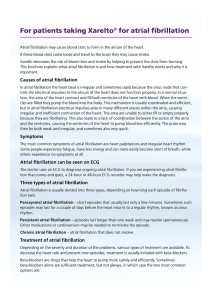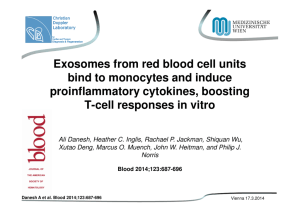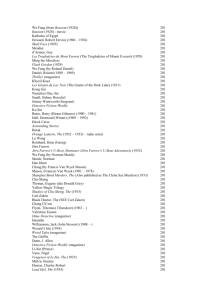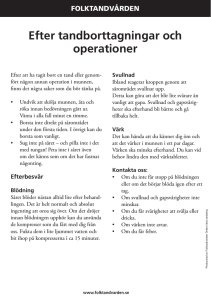For patients taking Xarelto® for blood clots in the leg and/or lung
advertisement
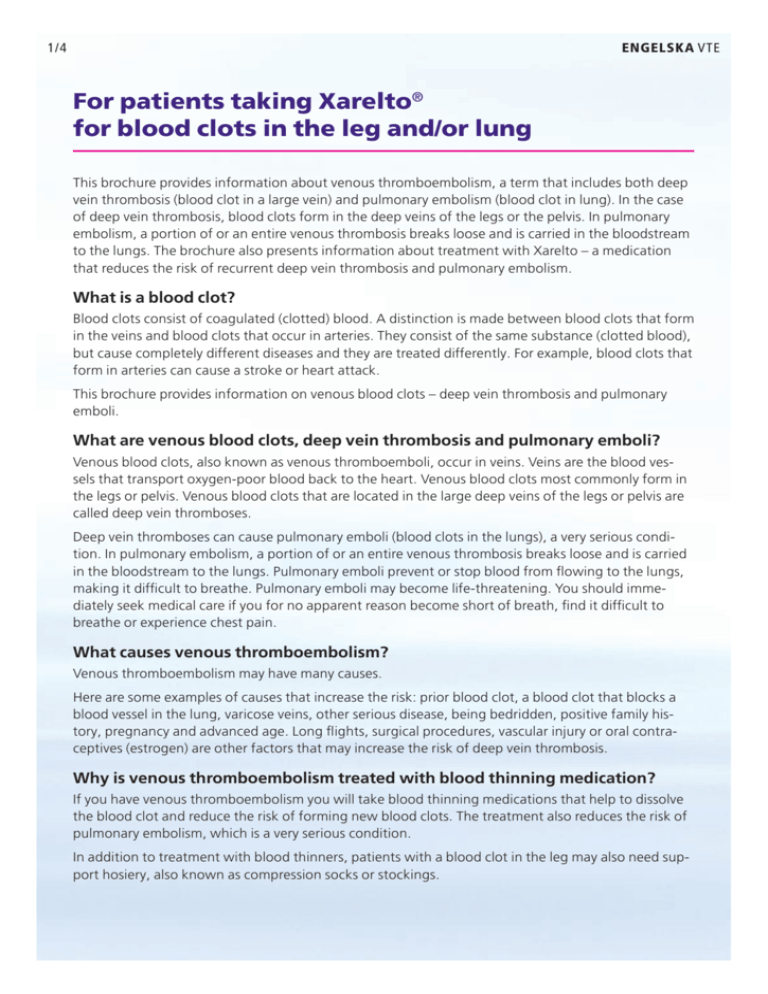
Engelska VTE 1/4 For patients taking Xarelto® for blood clots in the leg and/or lung This brochure provides information about venous thromboembolism, a term that includes both deep vein thrombosis (blood clot in a large vein) and pulmonary embolism (blood clot in lung). In the case of deep vein thrombosis, blood clots form in the deep veins of the legs or the pelvis. In pulmonary embolism, a portion of or an entire venous thrombosis breaks loose and is carried in the bloodstream to the lungs. The brochure also presents information about treatment with Xarelto – a medication that reduces the risk of recurrent deep vein thrombosis and pulmonary embolism. What is a blood clot? Blood clots consist of coagulated (clotted) blood. A distinction is made between blood clots that form in the veins and blood clots that occur in arteries. They consist of the same substance (clotted blood), but cause completely different diseases and they are treated differently. For example, blood clots that form in arteries can cause a stroke or heart attack. This brochure provides information on venous blood clots – deep vein thrombosis and pulmonary emboli. What are venous blood clots, deep vein thrombosis and pulmonary emboli? Venous blood clots, also known as venous thromboemboli, occur in veins. Veins are the blood vessels that transport oxygen-poor blood back to the heart. Venous blood clots most commonly form in the legs or pelvis. Venous blood clots that are located in the large deep veins of the legs or pelvis are called deep vein thromboses. Deep vein thromboses can cause pulmonary emboli (blood clots in the lungs), a very serious condition. In pulmonary embolism, a portion of or an entire venous thrombosis breaks loose and is carried in the bloodstream to the lungs. Pulmonary emboli prevent or stop blood from flowing to the lungs, making it difficult to breathe. Pulmonary emboli may become life-threatening. You should immediately seek medical care if you for no apparent reason become short of breath, find it difficult to breathe or experience chest pain. What causes venous thromboembolism? Venous thromboembolism may have many causes. Here are some examples of causes that increase the risk: prior blood clot, a blood clot that blocks a blood vessel in the lung, varicose veins, other serious disease, being bedridden, positive family history, pregnancy and advanced age. Long flights, surgical procedures, vascular injury or oral contraceptives (estrogen) are other factors that may increase the risk of deep vein thrombosis. Why is venous thromboembolism treated with blood thinning medication? If you have venous thromboembolism you will take blood thinning medications that help to dissolve the blood clot and reduce the risk of forming new blood clots. The treatment also reduces the risk of pulmonary embolism, which is a very serious condition. In addition to treatment with blood thinners, patients with a blood clot in the leg may also need support hosiery, also known as compression socks or stockings. Engelska VTE 2/4 Xarelto Xarelto belongs to a class of medications known as anticoagulants, i.e., blood-thinning medications. Xarelto reduces the ability of the blood to clot, thereby protecting against formation of blood clots. Xarelto works by blocking a specific factor in the blood – coagulation factor Xa. Xarelto is a prescription drug. Treatment with Xarelto Duration of treatment Treatment with Xarelto should continue as long as your doctor feels there is a risk of forming new blood clots. It is important that you do not stop your treatment without first speaking with your doctor. How to take Xarelto Try to take the tablet at the same time each day so it will be easier to remember. It is important to take Xarelto with food to provide maximum protection. Food and drink You may eat what you want; alcohol in moderation does not affect treatment. Dosage During the first three weeks of treatment you will take Xarelto 15 mg twice daily. Thereafter you will take Xarelto 20 mg once daily for the duration of the treatment period. If you forget to take a tablet ♦♦ During the first three weeks of treatment you will take Xarelto 15 mg twice daily together with breakfast and dinner. If you forget one dose, take the tablet as soon as you remember to ensure a total daily intake of 30 mg of Xarelto ♦♦ Subsequently, after the first three weeks of treatment, you will take Xarelto 20 mg once daily together with a meal. If you forget one dose, take the tablet as soon as you remember If you miss a full day, continue with your regular dose on the following day as before. Never double your dose to make up for a missed tablet. If you take too much Xarelto Contact your doctor immediately if you have taken too many tablets. The risk of bleeding increases if you take too much Xarelto. Possible side effects All medications may cause side effects, though not all users are affected. Contact your clinic for advice if you notice bleeding from sites such as your nose, mouth, urinary tract or intestinal tract. Seek emergency care if you experience heavy bleeding or bleeding that does not stop by itself. If you experience a sharp blow to the stomach, chest or head, you should also seek emergency care to make sure you have no internal bleeding. Also seek emergency care if you experience unusual weakness, fatigue, pallor, dizziness, headaches, unexplained swelling, increased shortness of breath, chest pain or angina – symptoms that may be signs of bleeding. Engelska VTE 3/4 Interaction with other medications Do not take anti-inflammatory medications such as Voltaren, Naproxen or aspirin without first asking your doctor. You may take pain relievers containing paracetamol (acetaminophen) such as Alvedon or Panodil along with Xarelto. It is important that you inform your doctor about what other medications you may be taking, including over the counter medications and herbal medicinal products. Your doctor will decide what treatment is indicated. Restrictions Contact your doctor before taking Xarelto if: ♦♦ you are allergic (hypersensitive) to rivaroxaban or any other ingredient in Xarelto ♦♦ you have a lot of bleeding, or ongoing bleeding ♦♦ you have liver disease that puts you at increased risk of bleeding ♦♦ you are pregnant or nursing Also contact your doctor if you are planning to become pregnant. Elective surgery, biopsy or dental procedures If you are going to have elective surgery, biopsy or a dental procedure such as tooth extraction, you should contact and inform your doctor or dentist that you are taking Xarelto. Regular blood testing is not necessary The effect of Xarelto does not differ significantly among individuals. Xarelto should be taken with food to ensure uptake of the drug, but no special dietary adjustments are necessary. Therefore you do not need regular blood testing to monitor the effect. By taking Xarelto as prescribed every day you should experience the benefit of the medication. Information card for your safety You will receive a card from your doctor or nurse containing information about your treatment with Xarelto. You should always bring your card with you when visiting or receiving treatment from a doctor, dentist or other healthcare provider. Do you have any questions about Xarelto? Talk to your doctor or nurse at the clinic that is managing your treatment. For complete information, please see the package leaflet. Would you like a daily reminder via text message? Register at www.xarelto-patient.se Please note that this service is in Swedish. Engelska VTE 4/4 Xarelto (rivaroxaban), antitrombotiskt medel, ℞ (B01 AF01). Tabletter 15 mg, 20 mg. Indikationer: 15 mg och 20 mg: Förebyggande av stroke och systemisk embolism hos vuxna patienter med icke-valvulärt förmaksflimmer med en eller flera riskfaktorer, såsom hjärtsvikt, hypertoni, ålder ≥ 75 år, diabetes mellitus, tidigare stroke eller transitorisk ischemisk attack (F). Behandling av djup ventrombos (DVT) och lungemboli (LE), och förebyggande av återkommande DVT och LE hos vuxna (F). Dosering: Förebyggande av stroke och systemisk embolism: rekommenderad dos är 20 mg en gång dagligen, vilket också är den rekommenderade maxdosen. Behandling av DVT och LE och förebyggande av återkommande DVT och LE: rekommenderad dos för initial behandling av akut DVT eller LE är 15 mg två gånger dagligen under de första tre veckorna, följt av 20 mg en gång dagligen för fortsatt behandling och förebyggande av återkommande DVT och LE. Särskilda patientpopulationer: För patienter med måttligt (kreatininclearance 30–49 ml/min) eller svårt (kreatininclearance 15–29 ml/min) nedsatt njurfunktion gäller följande doseringsrekommendationer: Vid förebyggande av stroke och systemisk embolism hos patienter med icke-valvulärt förmaksflimmer är den rekommenderade dosen 15 mg en gång dagligen. Vid behandling av DVT och LE och förebyggande av återkommande DVT och LE: patienterna ska behandlas med 15 mg två gånger dagligen under de första tre veckorna. Därefter är den rekommenderade dosen 20 mg en gång dagligen. En sänkning av dosen från 20 mg en gång dagligen till 15 mg en gång dagligen bör övervägas om patientens risk för blödning bedöms överstiga risken för återkommande DVT och LE. Patienter med förmaksflimmer som genomgår konvertering: Behandling med Xarelto kan initieras eller fortskrida hos patienter som kan behöva konvertering. Kontraindikationer: Överkänslighet mot den aktiva substansen eller mot något hjälpämne som anges i avsnitt 6. Aktiv, kliniskt signifikant blödning. Organskada eller tillstånd, som anses utgöra en ökad risk för större blödning. Detta kan omfatta pågående eller nyliga ulcerationer i magtarmkanalen, förekomst av maligna tumörer med hög blödningsrisk, nyliga hjärn- eller ryggradsskador, nyligen genomgången hjärn-, ryggrads- eller ögonkirurgi, nyligen genomgången intrakraniell blödning, kända eller misstänkta esofagusvaricer, arteriovenösa missbildningar, vaskulära aneurysm eller större intraspinala eller intracerebrala vaskulära missbildningar. Samtidig behandling med andra antikoagulantia, t.ex. ofraktionerat heparin (UFH), lågmolekylärt heparin (enoxaparin, dalteparin etc.), heparinderivat (fondaparinux etc.), orala antikoagulantia (warfarin, dabigatranetexilat, apixaban etc.), förutom vid byte av behandling till eller från rivaroxaban eller när UFH ges i doser som krävs för att hålla en central ven- eller artärkateter öppen. Leversjukdom förknippad med koagulopati och kliniskt relevant blödningsrisk inklusive cirrotiska patienter med Child Pugh B och C. Graviditet och amning. Varningar och försiktighet: Xarelto ska användas med försiktighet hos patienter med kreatininclearance 15–29 ­ml/­min. Användning av Xarelto hos patienter med kreatininclearance < 15 ­ml/­min rekommenderas inte. Hos flera undergrupper av patienter föreligger en ökad blödningsrisk. Dessa patienter ska övervakas noga för tecken på blödningskomplikationer efter att behandlingen inletts. För fullständig information om varningar och försiktighet var god se ­www.­fass.­se. Förpackningar och förmån: 15 mg: 28 tabl. (F), 42 tabl. (F), 98 tabl. (F), 100 tabl. (F). 20 mg: 28 tabl. (F), 98 tabl. (F), 100 tabl. (F). För ytterligare information och prisuppgift var god se ­www.­fass.­se. Datum för senaste översynen av produktresumén december 2014. Bayer AB. Box 606. 169 26 Solna. Tel. 08-580 223 00. ▼ Detta läkemedel är föremål för utökad övervakning. L.SE.02.2015.1574 Februari 2015 Översättningen är utförd av AAR Translator AB, ett professionellt ISO 9001-certifierat översättningsföretag med kompetens att översätta från svenska till engelska. Vi intygar härmed att denna översättning, enligt vår professionella kunskap, motsvarar dokumentet Patientbroschyr (VTE) på svenska. Bayer AB. Box 606. 169 26 Solna. Tel. 08-580 223 00.
